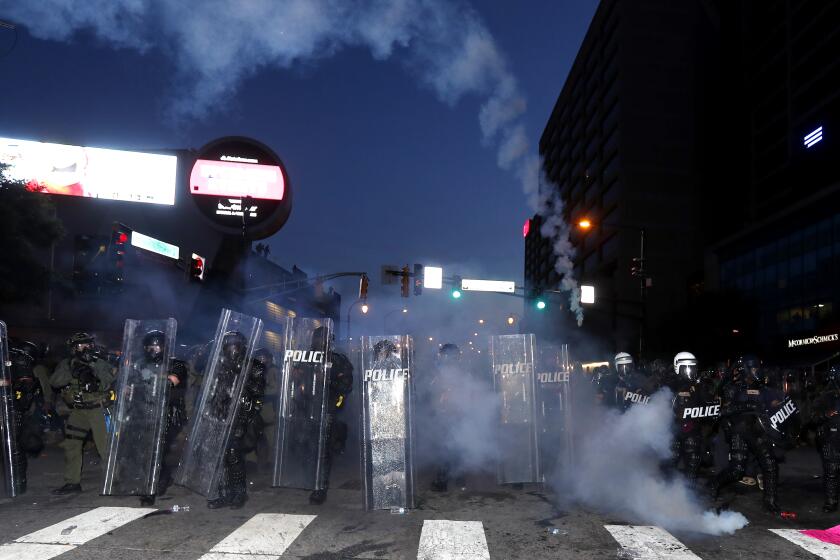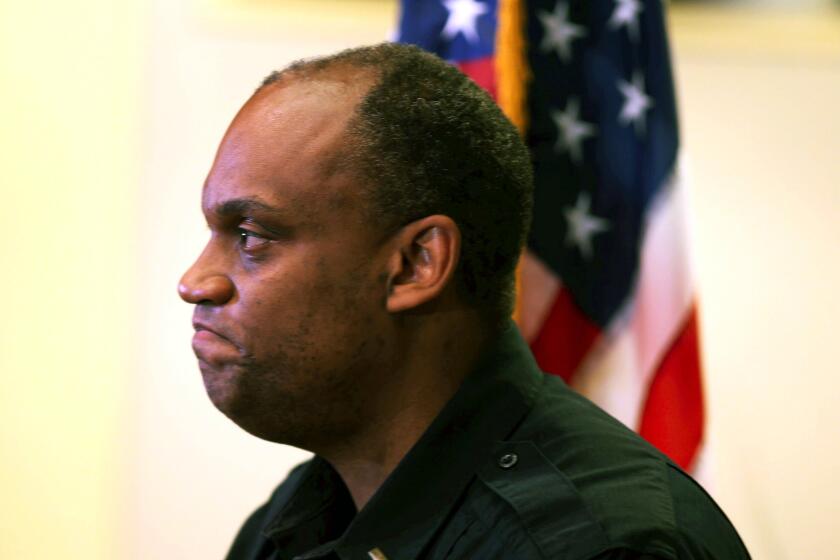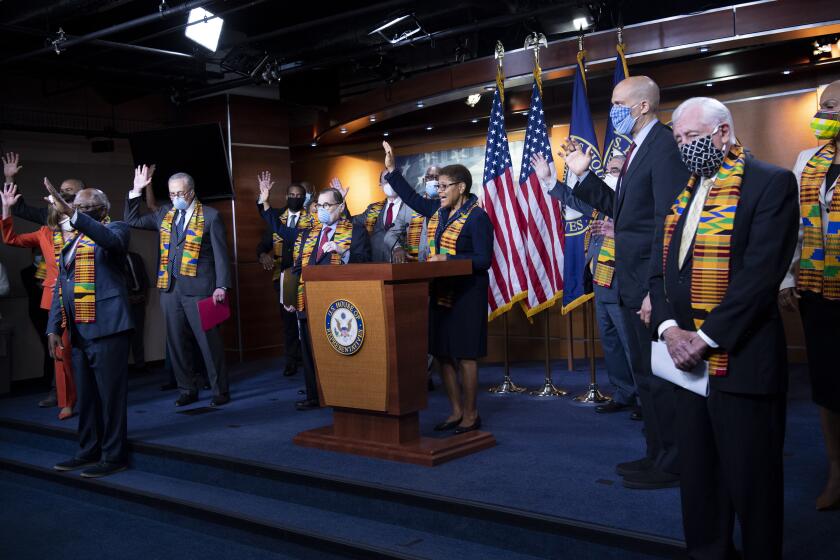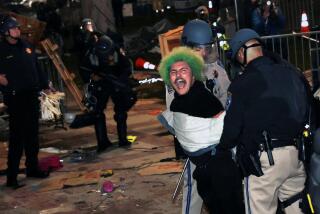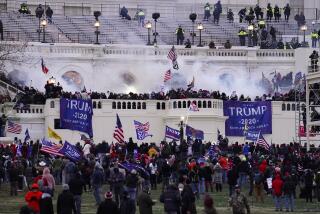Some U.S. lawmakers plan to propose a ban on police use of tear gas, which was deployed during peaceful protests

HOUSTON — A group of congressional lawmakers wants to ban police from using tear gas, which was deployed against peaceful demonstrators protesting George Floyd’s death, in the latest effort to restrict law enforcement’s use of chemical and other “less lethal” weapons on civilians.
Federal funding would be denied to police agencies that refuse to comply with the ban and dispose of tear gas in their arsenal under legislation to be proposed Thursday by Democratic Reps. Alexandria Ocasio-Cortez of New York, Mark Takano of Riverside and Jesus “Chuy” Garcia of Chicago.
“Last week, people were just so shocked to see this administration tear-gas its own people. Tear gas is a chemical weapon that is used in war,” Ocasio-Cortez said during a phone call with the other lawmakers and the Los Angeles Times this week. “It is one of the most basic steps we can take.”
Police are supposed to follow manufacturers’ instructions and deploy tear gas when people have a clear exit route, but that did not appear to be the case in Washington, D.C., Minneapolis and other sites of recent peaceful protests where participants and journalists were injured.
A White House spokeswoman has denied that tear gas was used against protesters in Washington as police cleared a park in advance of a visit by President Trump to a nearby church last week.
“The administration denied they were using it, but indeed they found there were cartridges marked ‘CS,’” another term for tear gas, Takano said.
A look at how police nationwide have responded to protesters.
The lawmakers said they were proposing the ban this week to protect civilians from the long-term respiratory effects of tear gas that could put them at added risk during the COVID-19 pandemic, especially if they are gassed and then arrested and held together.
“In a pandemic situation, it can increase the risk of infection,” Takano said — a particular concern for minority communities already experiencing disproportionate rates of infection.
Police have been criticized in recent weeks for using tear gas against protesters in other cities, including Atlanta, New York, Los Angeles, Seattle, Portland, Ore., and Minneapolis, where Floyd died at the hands of police May 25. Although tear gas is banned during wartime by international treaties, loopholes allow countries to use it against civilians.
Some police have defended tear gas as a necessary tool to disperse crowds.
Minneapolis police backed an L.A. Times reporter and photographer against a wall and fired tear gas and rubber bullets at point blank range
The president of Portland’s police union told a local radio station that tear gas was considered a “best practice” for controlling crowds.
“If they deem that we can’t use it, we’ll have to use something else, a less lethal option,” Portland Police Assn. President Daryl Turner told KOPB-FM radio, warning that a ban caused police “to have to use more hands-on force because they take one option away that could help disperse crowds, help keep people safe.”
Turner dismissed concerns about the lasting health effects of tear gas, saying: “It has a short-time period that it affects people and wears off easily with washing down with water.”
Portland city commissioners called for a ban on tear gas this month after protesters filed a class-action lawsuit against the city for the “indiscriminate use” of tear gas during nightly protests following Floyd’s death. Mayor Ted Wheeler, who is also the police commissioner, has said he will support the proposed ban if police have an alternative for crowd control.
Other cities have tried to stop police from using tear gas, with mixed results. In Seattle, the mayor and police chief announced last week that they were banning tear gas for a month only to see officers use it days later to quell protests.
Portland’s police chief has resigned, just six months into her job, amid criticism of her department’s handling of protests in Oregon’s largest city
In Los Angeles, activists sued the city last week, accusing police of using excessive force on protesters after LAPD Chief Michel Moore said the department needed to show more force in response to burglaries and vandalism and dozens of attacks on police, one of whom was hospitalized with a fractured skull.
The Berkeley City Council voted Tuesday to end police use of tear gas, tweeted council member Rigel Robinson. The vote came after a council member asked the Berkeley police chief what he would do to disperse protesters if he couldn’t use tear gas, and he jokingly responded: “We could shoot them.”
There’s a reason police are hesitant to abandon tear gas, said Phillip Atiba Goff, a professor in policing equity at John Jay College of Criminal Justice and co-founder of the Center for Policing Equity.
“Tear gas is a nonlethal way to ensure that situations that are escalating into violence won’t get there. We’ve talked to chiefs who say, ‘If we can’t use tear gas, our officers are going to take rocks and bottles,’” Goff said, adding: “The reality is people do go to the hospital, and it can lead to serious illness and death.”
In working with police across the country, he said, “we’ve advised law-enforcement agencies to stop using tear gas in the time of COVID because there’s good evidence it increases the likelihood of contracting it. And chiefs are listening.”
Goff noted that tear gas is just one of an arsenal of “weapons of war” and decommissioned military equipment that U.S. police have accumulated in recent years, and that the more those are abandoned, “the more the perception of police changes and possibly even the mindset of the law enforcement. The more we take those things away, the more likely it is that we feel less occupied.”
The bill, led by Rep. Karen Bass (D-Los Angeles) and Sen. Kamala Harris (D-Calif.), makes it easier to sue police officers.
Tear gas is actually not a gas; it’s a powder dispersed by explosives from a canister, like firecrackers. It’s produced by a handful of manufacturers, mostly based in the U.S.
Developed during World War I, the chemical was refined over the years as it was used to suppress protests by U.S. unions, against colonial powers in Asia and Africa, and during wars in Vietnam and Iraq. More recently, it’s been used by governments to suppress protests in Hong Kong and the Middle East, sometimes with deadly results.
The metal from tear gas canisters can severely damage people’s eyes as it has during recent U.S. protests, as the canisters can fracture and the metal becomes embedded in a person’s eyes or skull, said Sven-Eric Jordt, an associate professor of anesthesiology at Duke University School of Medicine, who has researched the health effects of chemical weapons.
“The research has not really caught up with the escalating use by police and law enforcement. We’ve seen a dramatic increase in use in Hong Kong and, before that, in Turkey, Chile, Brazil and the Arab Spring uprisings,” Jordt said.
Congress passed a law last year that prevented U.S. manufacturers from shipping tear gas to Hong Kong, but police there just bought Chinese tear gas instead, he said. Chile imposed a temporary moratorium on tear gas in 2011, but it didn’t last. Despite deaths during Arab Spring protests, when demonstrators were hit with tear gas canisters, the U.S. continued manufacturing it.
“This is now coming home,” Jordt said. “… There’s been no oversight by local authorities who fund these police departments. It’s really stunning that no one realizes these departments are buying more and more of these [chemical] agents.”
Breaking News
Get breaking news, investigations, analysis and more signature journalism from the Los Angeles Times in your inbox.
You may occasionally receive promotional content from the Los Angeles Times.
The U.S. military studied the effect of tear gas on 6,000 healthy recruits several years ago and found the recruits had a much higher likelihood of developing a respiratory illness, including the flu, Jordt said.
“That raises a lot of concern that the general population — protesters on a much wider spectrum of age and constitution — might respond with an even higher rate of infection,” he said. “If there is a protester who is exposed who has non-symptomatic or asymptomatic COVID, just by coughing or screaming they could spread the COVID widely to protesters and police.”
Jordt said his concern was not limited to tear gas but extended to pepper spray, “sting ball grenades” and other new chemical weapons police have used recently to disperse protesters.
More to Read
Sign up for Essential California
The most important California stories and recommendations in your inbox every morning.
You may occasionally receive promotional content from the Los Angeles Times.

